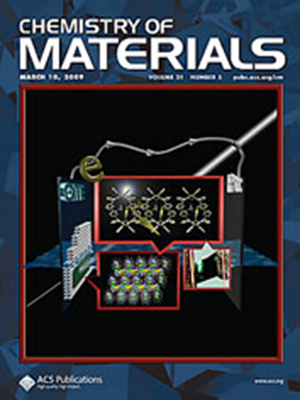Atomic-Scale Polar Helix in Inorganic Crystals
IF 7
2区 材料科学
Q2 CHEMISTRY, PHYSICAL
引用次数: 0
Abstract
Chiral structures, noncentrosymmetric objects with a given handedness, emerge on all scales in nature. The most well-known chiral form, the helix, has numerous materializations not only on the microscopic scale (DNA, cholesteric liquid crystals, and spin helices) but also on macroscopic and even cosmological scales. The ongoing quest for new types of chiral structures is fueled by a wide range of fascinating phenomena observed in chiral materials, such as nonreciprocal transport and optical processes, electro-optical effects, and chiral amplification and induction. Here, we report a novel route to chirality in antipolar GaTa4Se8 crystals, where the rotation of the electric polarization vector through the unit cell traces out a helix. The determination of atomic positions using X-ray diffraction combined with ab initio calculations reveals that quasi-molecular Ta4Se4 clusters distort upon a phase transition and evoke significant local electric polarization within structural layers of the unit cell. This polarization is found to rotate in 90° steps between neighboring layers, either clockwise or anticlockwise. A similar analysis performed on two archetypal chiral compounds, α-quartz and tellurium, implies that antipolar crystals with screw-axis symmetry may generally host atomic-scale polarization helices with emergent functionalities.无机晶体中的原子级极性螺旋
手性结构,即具有特定手性的非中心对称物体,出现在自然界的各个尺度上。最著名的手性形式--螺旋,不仅在微观尺度上(DNA、胆甾液晶和自旋螺旋),而且在宏观甚至宇宙尺度上都有许多具体化。在手性材料中观察到的各种奇妙现象,如非互惠传输和光学过程、电光效应以及手性放大和诱导等,推动了人们对新型手性结构的不断探索。在这里,我们报告了一条在反极性 GaTa4Se8 晶体中实现手性的新途径,在这种晶体中,电偏振矢量通过单位晶胞的旋转描绘出一条螺旋线。利用 X 射线衍射测定原子位置并结合 ab initio 计算发现,准分子 Ta4Se4 团簇在相变时会发生扭曲,并在单位晶胞的结构层内产生显著的局部电极化。研究发现,这种极化在相邻层之间以 90° 为单位顺时针或逆时针旋转。对两种典型手性化合物--α-石英和碲--进行的类似分析表明,具有螺轴对称性的反极性晶体通常可能含有具有新兴功能的原子级极化螺旋。
本文章由计算机程序翻译,如有差异,请以英文原文为准。
求助全文
约1分钟内获得全文
求助全文
来源期刊

Chemistry of Materials
工程技术-材料科学:综合
CiteScore
14.10
自引率
5.80%
发文量
929
审稿时长
1.5 months
期刊介绍:
The journal Chemistry of Materials focuses on publishing original research at the intersection of materials science and chemistry. The studies published in the journal involve chemistry as a prominent component and explore topics such as the design, synthesis, characterization, processing, understanding, and application of functional or potentially functional materials. The journal covers various areas of interest, including inorganic and organic solid-state chemistry, nanomaterials, biomaterials, thin films and polymers, and composite/hybrid materials. The journal particularly seeks papers that highlight the creation or development of innovative materials with novel optical, electrical, magnetic, catalytic, or mechanical properties. It is essential that manuscripts on these topics have a primary focus on the chemistry of materials and represent a significant advancement compared to prior research. Before external reviews are sought, submitted manuscripts undergo a review process by a minimum of two editors to ensure their appropriateness for the journal and the presence of sufficient evidence of a significant advance that will be of broad interest to the materials chemistry community.
 求助内容:
求助内容: 应助结果提醒方式:
应助结果提醒方式:


